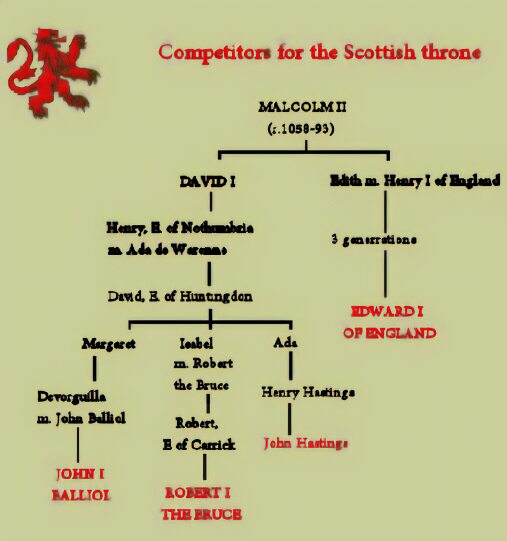1292-1296
John Balliol was born in 1248, most probably at Barnard Castle in Northumbria, he was the son of John, Baron Balliol, (the founder of Balliol College, Oxford) and his wife Devorguilla of Galloway, and through his mother derived his claim to the throne of Scotland, Devorguilla was the granddaughter of David, Earl of Huntingdon, himself the grandson of David I. Robert the Bruce's grandfather, known as 'Robert the Competitor' was a further claimant. In the male line, the House of Balliol was an Anglo-Norman family who began to rule some estates in England in the reign of William II 'Rufus'.
John Balliol pays homage to Edward I
Robert the Bruce based his claim on his descent from Isabella, David's second daughter. Edward I, one of the most formidable of English Kings was asked by the Scots to arbitrate between the Competitors for the honour. He decided in favour of John Balliol. Balliol was duly crowned King of Scots on St. Andrew's Day, 30th November 1292 at Scone.
The new King of Scots was married to Isabella, daughter of John de Warenne, Earl of Surrey and Alice de Lusignan. Isabella's maternal grandparents were Hugh X de Lusignan and Isabella of Angouleme, the widow of King John of England.
The slighted Bruces defiantly refused to pay homage to King John. The opportune Edward I had hoped to personally gain by his involvement in Scottish affairs and in 1293 he declared the treaty of Birgham void, rendering his puppet, King John, known as Tom Tabard (i.e. empty garment) with little actual power. A Scottish council was elected by the nobility to govern the country. They negotiated an alliance with France and declared war on the English in the name of the humiliated King John.
The Scots then attacked the border town of Carlisle, which the Bruce family defended against them. Edward gathered an army and in retaliation sacked Berwick, the English army then marched on into Scotland. Balliol surrendered to Edward, now in effective control of the country. On 10th July 1296, the puppet King John was forced to abdicate his throne, the English King had him taken south and imprisoned him in the Tower of London. John Balliol died before 1315 on his family estates at Bailleul, France. He was succeeded on Scotland's throne by Robert the Bruce.
William Wallace, the great Scots patriot.
Rebel and outlaw guerilla bands continued the struggle for Scotland's independence and proceeded to attack the English, ably led by the great Scottish patriot, William Wallace. Robert the Bruce was issued with orders to put down the rebellion. Robert had conflicting loyalties, he held lands in England for which he owed King Edward homage but as he was a Scotsman, and accordingly, he eventually decided to join the rebels.

William Wallace, Scotland's most famous son, met the English in pitched battle at Stirling Bridge, the result was a famous victory for Scotland. Wallace was appointed Guardian of the country, to rule in the name of the captive King John. He evoked much love and reverence from the common people who saw him as their champion and protector against English oppression.
In 1298, Wallace again met the English in battle at Falkirk, this time Wallace tasted bitter defeat, Scots casualties were great and Wallace himself was forced to flee. The guardianship of Scotland passed jointly to Bruce and John the Red Comyn, the nephew of Balliol and already an enemy of the Bruces. Bruce was reluctant to fight to support Balliol's claim and accordingly surrendered to Edward in 1302.
In 1305, Wallace was treacherously betrayed by a fellow Scot and captured by the English. He was taken to London and put on trial for treason against Edward I, although he had never sworn fealty to him. He was subjected to an appalling and barbaric death, being hung, drawn and quartered. William Wallace remains a national hero amongst the Scottish people.
